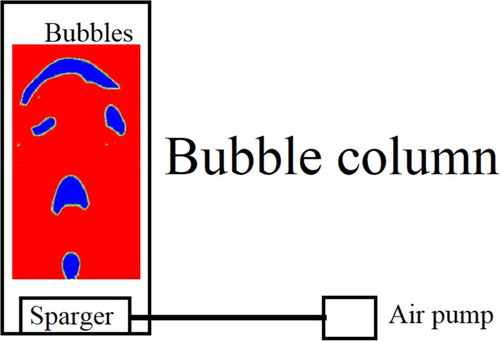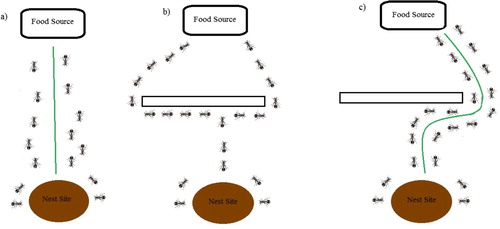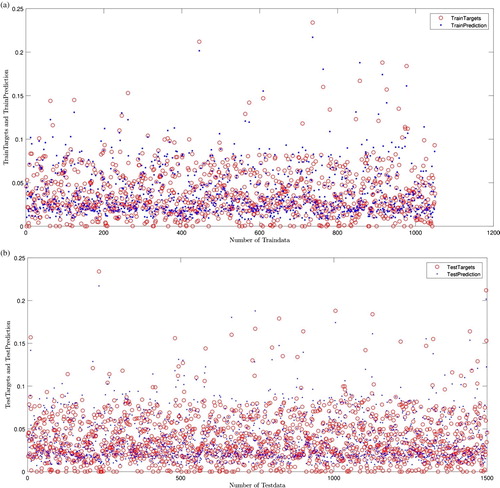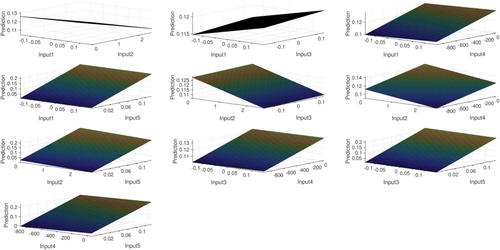 ?Mathematical formulae have been encoded as MathML and are displayed in this HTML version using MathJax in order to improve their display. Uncheck the box to turn MathJax off. This feature requires Javascript. Click on a formula to zoom.
?Mathematical formulae have been encoded as MathML and are displayed in this HTML version using MathJax in order to improve their display. Uncheck the box to turn MathJax off. This feature requires Javascript. Click on a formula to zoom.Abstract
A novel combination of the ant colony optimization algorithm (ACO)and computational fluid dynamics (CFD) data is proposed for modeling the multiphase chemical reactors. The proposed intelligent model presents a probabilistic computational strategy for predicting various levels of three-dimensional bubble column reactor (BCR) flow. The results prove an enhanced communication between ant colony prediction and CFD data in different sections of the BCR.
1. Introduction
Multiphase bubble column reactor (BCR) types are highly important for different industries because of their applications and efficiency (Kumar, Degaleesan, Laddha, & Hoelscher, Citation1976; Li & Prakash, Citation2002; Schäfer, Merten, & Eigenberger, Citation2002). A BCR’s structure is composed of a cylindrical vessel with a gas distributor at the bottom section so that the gas bubbles are fed into the reactor (Bouaifi, Hebrard, Bastoul, & Roustan, Citation2001; Dhotre, Ekambara, & Joshi, Citation2004; Lefebvre & Guy, Citation1999; Shah, Kelkar, Godbole, & Deckwer, Citation1982). Therefore, the gas is sparked in other phases for separation or chemical reaction. Moreover, this phase may have two forms; i.e. liquid–solid mix and liquid phase (Cho, Woo, Kang, & Kim, Citation2002; Kantarci, Borak, & Ulgen, Citation2005; Pino et al., Citation1992; Pourtousi, Sahu, & Ganesan, Citation2014). The BCR is particularly beneficial in petrochemical, chemical, metallurgical, and biochemical industries, and they are utilized as multiple reactors and contactors since these fluid-structure domains give a large surface area (Bombač, Rek, & Levec, Citation2019; Rieth & Grünewald, Citation2019; Shi et al., 2019; Shu, Vidal, Bertrand, & Chaouki, Citation2019). The BCRs in different industries such as pharmaceutical or biochemical are used in the processes that involve reactions such as chlorination, oxidation, polymerization, hydrogenation, and alkylation, which are advantageous for the production of synthetic fuels(Chen, Hasegawa, Tsutsumi, Otawara, & Shigaki, Citation2003; Ruzicka, Zahradnık, Drahoš, & Thomas, Citation2001; Sokolichin & Eigenberger, Citation1994; Wang et al., Citation2003). The Fischer–Tropsch process is considered as a major application of the mentioned reactors in the chemical industries (Prakash, Margaritis, Li, & Bergougnou, Citation2001). It is the process of indirect coal liquefaction, resulting in various kinds of fuels like synthetic fuels, methanol synthesis, and transportation fuels (Chuntian & Chau, Citation2002; Maalej, Benadda, & Otterbein, Citation2003; Rabha, Schubert, & Hampel, Citation2013). The production of these kinds of fuels is environmentally advantageous compared to the fuels derived from petroleum (Behkish, Men, Inga, & Morsi, Citation2002; Kantarci et al., Citation2005; Michele & Hempel, Citation2002). The BCRs are extensively used due to their specific operation and design. The high heat transfer coefficients are characteristics of the bubble columns (Buwa & Ranade, Citation2003; Kantarci et al., Citation2005; Krishna & Van Baten, Citation2003; Leonard, Ferrasse, Boutin, Lefevre, & Viand, Citation2015; Luo, Lee, Lau, Yang, & Fan, Citation1999). As the advantage of the bubble columns, it can be stated that a catalyst or other packing chemical components are able to stay a long period even though they are extensively used (Asil, Pour, & Mirzaei Citation2018; Kannan, Naren, Buwa, & Dutta, Citation2019; Liu & Luo, Citation2019; Shi, Yang, Li, Zong, & Yang, Citation2019; Xin, Zhang, He, & Wang Citation2019). Also, it is possible to add or remove the online catalyst easily(Deen, Solberg, & Hjertager, Citation2000; Díaz et al., Citation2008; Masood & Delgado, Citation2014; Shimizu, Takada, Minekawa, & Kawase, Citation2000; Thorat & Joshi, Citation2004). Thus, the bubble columns are used in biochemical and chemical industries. In order to get effective BCRs, it is necessary to consider their design scale(Krishna, Baten, & Urseanu, Citation2001; Masood, Khalid, & Delgado, Citation2015). Hence, if the reactors are improved by computation and simulation of the column’s hydrodynamics, then a perfect understanding concerning the process can be provided (Pourtousi, Ganesan, & Sahu, Citation2015; Razzaghian, Pourtousi, & Darus, Citation2012; Verma & Rai, Citation2003). Various numerical methods are available for estimation of the multiphase flow in the BCRs. Nevertheless, the scholars have difficulties in the simulation of the full gas movement (Besagni, Guédon, & Inzoli, Citation2018; Li & Prakash, Citation2001; Silva, d’Ávila, & Mori, Citation2012). In order to numerically simulate complex turbulence behavior in the two-phase reactor, often the supercomputers provide the opportunity to calculate the liquid flow in the very complicated geometries. In experimental observation, If the fluid flow is needed to be measured during operation, because of the requirement for the high-speed microscopic cameras and modern probes, it is not economical (Besagni, Guédon, & Inzoli, Citation2016; Clift, Citation1978; Pourtousi, Zeinali, Ganesan, & Sahu, Citation2015; Rzehak & Krepper, Citation2013; Wang et al., Citation2014). Moreover, the other constraint of the approach in the prediction of large BCRs is related to the computational costs at varying operational conditions and different times (Cartland Glover, Blažej, Generalis, & Markoš, Citation2003; Ekambara, Dhotre, & Joshi, Citation2005; Hecht & Grünewald, Citation2019; Jamialahmadi & Müller-Steinhagen, Citation1992; Joshi, Citation2001). These limitations gave way to the application of the intelligent algorithms for simulation of BCRs (Burns, Frank, Hamill, & Shi, Citation2004; Buwa, Deo, & Ranade, Citation2006; Pourtousi, Citation2016; Xing, Wang, & Wang, Citation2013).
Support vector machines (Moazenzadeh, Mohammadi, Shamshirband, & Chau, Citation2018), neural networks (Taherei Ghazvinei et al., Citation2018), simulated annealing, and evolutionary algorithms are some of the soft-computing approaches that can be applied for predicting and simulating the chemical processes(Mahmoud & Ben-Nakhi, Citation2007; Ozsunar, Arcaklıoglu, & Dur, Citation2009; Sudhakar, Balaji, & Venkateshan, Citation2009). This system can direct the complicated relationships (Saleem, Di Caro, & Farooq, Citation2011). Using this approach, a smart way is provided for the estimation of the complicated mechanisms in engineering. A suitable example in this regard is the regulation of robotic movements in risky cases(Burns et al., Citation2004; Krishna, Urseanu, Van Baten, & Ellenberger, Citation1999; Rampure, Kulkarni, & Ranade, Citation2007). Thus, this approach is useful in order to control the robots in the cases that the chemical reactions may be dangerous for the people (Buwa et al., Citation2006; Simonnet, Gentric, Olmos, & Midoux, Citation2007; Xing et al., Citation2013).
As mentioned, soft modeling approaches pursue a smart process; thus, it is useful in decision-making because of its comprehensiveness and complex algorithm (Berrichi, Yalaoui, Amodeo, & Mezghiche, Citation2010). In addition, they can be devoid of various errors including the accuracy in monotonous conditions. In addition, using the different inputs and output procedure is beneficial when the output-input association is inherently meaningful (Lu & Liu, Citation2013). Therefore, the method’s learning process is completely dependent on the data both for experimental or simulated cases (Babanezhad, Rezakazemi, Hajilary, & Shirazian; Mosavi, Shamshirband, Salwana, Chau, & Tah, Citation2019; Mosavi et al., 2019; Jafari-Sejahrood et al., Citation2019; Shamshirband et al., Citation2019). The recent research works have been mainly focused on a specific dimension of soft-computing methods used for flow patterns production in the BCRs. According to the research works, the relationship between machine learning and CFD results in important concepts for the computation of different properties of BCRs. A number of researchers, e.g. Mohammad Pourtousi (Citation2016) used different type of big data in the bubble column reactor in the machine learning algorithm and they predicted pattern recognition of gas and liquid flow in the BCR (Fotovatikhah et al., Citation2018; Yaseen, Sulaiman, Deo, & Chau, Citation2018). In this study, the ant colony method is combined to predict the flow pattern in the BCR. The application of ant colony algorithm is an appropriate alternative rather than using the CFD approach, which is costly in terms of computation, for the flow simulation in BCRs. In this study, the flow characteristics were trained in the BCR by pheromone-based communication of biological ants and compare the results with existing CFD data (Marco Dorigo & Gambardella, Citation1997; Xu, Chen, Zhu, & Wang, Citation2010). As a combination of optimization methods and fuzzy system have not been fully used to simulate biological and physics-based phenomena. In this paper, the ant optimization method with the fuzzy system was used to predict continuous data. For the first time, the optimization method is used as a solver of machine learning to simulate bubble column characteristics.
2. Method
For the simulation of bubbling flow in the BCR, the Eulerian–Eulerian approach is used throughout the domain. This method can simulate the fraction of each phase in the domain and it is based on ensemble-averaged mass and momentum transport equations for each phase. For solving fluid flow in the BCR firstly the continuity equation was computed as follows:
(1)
(1)
Momentum transfer equation:
(2)
(2)
The total interfacial force schemes between the main phases are mainly drag and turbulent dispersion force. The overall forcing scheme is written as:
(3)
(3)
The details description of interfacial force methods that are utilized used in this investigation can be observed in (Mosavi et al., Citation2019a; Tabib, Roy, & Joshi, Citation2008). For calculation of the turbulence flow characteristics the k–ϵ model is utilized for calculation of turbulence behavior in the bubble column reactor. All turbulence model parameters are similar to k–e model (Pourtousi, Citation2016).
2.1. Geometrical structure
A BCR with a height of 2.6 m and a diameter of 0.288 m, is used, and a single sparger point is used at the bottom of the column with 0.5 m height. (see Figure ) The details description of boundary conditions such as slip boundary conditions and degassing pressure at the surface of the column in this investigation can be observed in Pfleger and Becker (Citation2001). The source point boundary condition used for a single Sparger is identical to Tabib et al. (Citation2008) and Mosavi et al. (Citation2019a).
2.2. Grid
A structured hexahedral grid is utilized for calculation of the whole fluid-structure and the interaction between liquid and gas.
2.3. ANT colony
In this study, the ant colony optimization method (ACO) is a technique for solving big data with complicated problem structures that can be decreased to discover good paths through graphs. Intelligent Ants or artificial algorithms of ant method stand for multi-agent methods to mimic the real behavior of ants. In this study, this method was used to predict the gas–liquid flow pattern in the column. More description about this method can be found in (Baker & Ayechew, Citation2003; Bell & McMullen, Citation2004; Blum, Citation2005; Castillo, Neyoy, Soria, García, & Valdez, Citation2013; M Dorigo, Birattari, & Stützle, Citation2006; Dorigo & Blum, Citation2005; Li, Sun, Sattar, & Corchado, Citation2014; Maroosi & Amiri, Citation2010; McMullen, Citation2001; Mocholi, Jaen, Catala, & Navarro, Citation2010; Mohan & Baskaran, Citation2012; Mullen, Monekosso, Barman, & Remagnino, Citation2009; Rao, Srinivasan, & Venkateswarlu, Citation2010; Suganthi & Samuel, Citation2012; Tian, Ma, & Yu, Citation2011; Valdez, Melin, & Castillo, Citation2014; Yu, Yang, & Yao, Citation2009) (see Figure ).
3. Results
In the present study, through simulating a cylindrical BCR reactor by the CFD method, different parameters of the fluid are acquired as the CFD outputs parameters. The output parameters consist of the x, y, and z coordinates which denote pressure, air superficial velocity, and air volume fraction, simultaneously. In this study, the CFD outputs were assessed by combining the intelligence optimization algorithm of ant colony and fuzzy inference system (FIS) with.
To use the Ant colony algorithm, part of the CFD outputs were considered as input and the others were considered as output. In this research, five inputs were utilized; the first input was the x coordinate, the second input was the y coordinate and the third was the z coordinate. The pressure which was one of the traits of the fluid inside the BCR is the fourth input; air superficial velocity another characteristic of the fluid inside BCR is the fifth input, whereas air volume fraction is considered as output. To initiate the learning process by artificial intelligence (ant colony algorithm), the following conditions are assumed:
The maximum iteration is 100, the total data number is 1500, the value of p represents a percentage of the data that has been used in the learning processes and is considered as %70. In the training process, %70 of the data were involved and %100 of the data were evaluated in the training process. The clustering type was assumed as Fuzzy c-means (FCM). With the above-mentioned assumptions, by considering the input of the x coordinates and the output of the air volume fraction, the training and testing processes were performed separately for 20, 30, and 40 numbers of ants. As presented in Figure , the best Regression (R) value is 0.30 for a number of 30 ants which shows that FIS does not have sufficient intelligence in the learning process using the ant colony algorithm, and the change in the number of ants has made no significant enhancement in the FIS intelligence.
Figure 3. Ant colony algorithm training and testing process with one input (number of ant = 20, 30, 40; number of data = 1500; max iteration = 100; P=%70; FCM clustering).
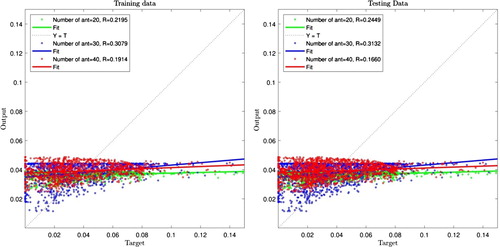
To boost the system intelligence, the number of inputs was increased and evaluated; the x coordinate and y coordinate were considered as inputs, and learning processes were carried out for 20, 30, and 40 ants separately. Figure does not show much enhancement in system intelligence.
Figure 4. Ant colony algorithm training and testing process with two inputs (number of ant = 20, 30, 40; number of data = 1500; max iteration = 100; P=%70; FCM clustering).
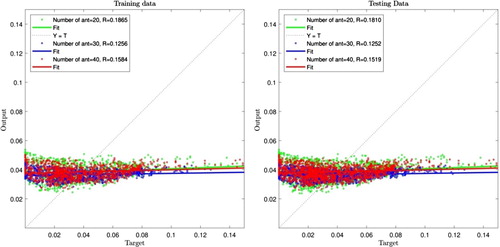
To elevate the ant colony algorithm intelligence, the increase in the number of inputs from 2 to 3 was considered and z coordinate was considered as third input and the air volume fractions were considered as output. By conducting separate training and testing procedures for various numbers of ants, no significant changes are observed in intelligence as shown in Figure .
Figure 5. Ant colony algorithm training and testing process with three inputs (number of ant = 20, 30, 40; number of data = 1500; max iteration = 100; P=%70; FCM clustering).
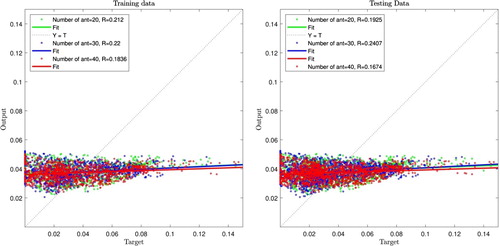
In this stage of the study, one of the characteristics of the fluid inside the BCR i.e. pressure was considered as the fourth input. The learning processes (training and testing) for 20, 30, and 40 ants were done separately, but unfortunately, there was still no significant effect on elevating the system intelligence. (See Figure )
Figure 6. Ant colony algorithm training and testing process with four inputs (number of ant = 20, 30, 40; number of data = 1500; max iteration = 100; P=%70; FCM clustering).
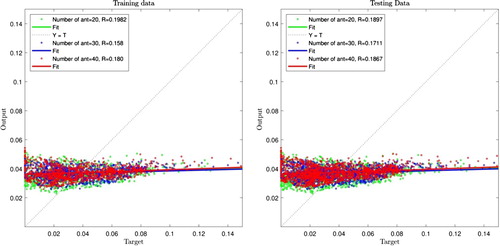
Afterward, in order to attain favorable system intelligence, another characteristic of the fluid inside BCR i.e. air superficial velocity was considered as the fifth input, and the learning processes were carried out for 20 ants. As presented in Figure , the value of R for the training process has increased from about 0.20 to 0.96 and for the testing process, it has increased to 0.95, which indicates a very favorable enhancement in the system intelligence and the achievement of complete intelligence for the system. Using this intelligence, various parts of the BCR can also be predicted. In Figure , points of BCR that participated in the learning process are observed that used in the ant colony algorithm learning process.
Figure 7. Ant colony algorithm training and testing process with five inputs when (number of ant = 20; the number of data = 1500; max iteration = 100; P=%70; FCM clustering).
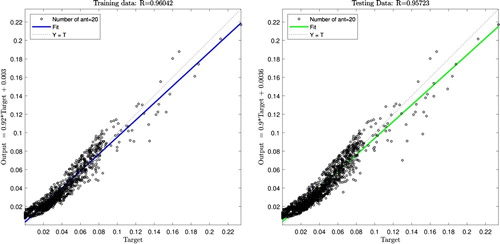
The combination of artificial intelligence (ant colony algorithm) and the CFD method decreases the required time for calculations by the CFD method, it also leads to avoiding the solving of complex equations by the CFD method; moreover, by exploiting the created intelligence, much more information and result points can be acquired.
A comparison of the CFD output nodes and ACO algorithm prediction nodes demonstrates a very favorable agreement between the CFD results and the ant colony algorithm output (see Figure (a,b)). Using this obtained intelligence, nodes that are not present in the learning process can be predicted and this shows the very favorable capacity of the artificial intelligence (ant colony algorithm), which is very advantageous and effective (see Figure ).
4. Conclusion
Current work describes the simulation of the gas fraction based on different bubble column characteristics with an ant colony approach. In particular, the CFD data are considered as training inputs of the ant colony method, and this method predicts the behavior of the bubble column reactor. The simulation of the gas fraction is implemented in a 3D domain of fluid-structure and it is compared with the results of CFD. In the training process, the reactor’s top bottom and middle levels are chosen for computing the BCR hydrodynamics because of the gas holdup behavior at the mentioned levels. The Ant colony method model is an appropriate tool for prediction with almost 30% of data in the learning state. Nevertheless, the tuning parameters of this model significantly enhance the ant colony method’s intelligence. Also, it is possible to train it in a highly short period of time (iteration), which provides a quick learning procedure having very small computational time and efforts. Moreover, as no obstacle of computational time is present, a higher amount of data can be generated in the input domain of data indicating novel reactor conditions with no experimental or numerical outcomes. This new perception of data analysis with artificial ants and local search algorithms is a sophisticated process for post-processing the data as other researchers started with other soft-computing methods. Prediction of the fluid flow around bubbles can be very complicated and estimation of the vortex structure near bubbles requires more training data. This new combination of CFD and AI can provide more tuning parameters in AI prediction of the reactor to achieve accurate prediction results, and enables us to organize data during training and optimization base on the biological overview. For future studies, other biological optimization methods can be combined with inference fuzzy system to predict the BCR hydrodynamics. However, the ant colony method can be modified based on different ants such as Tapinoma nigerrimum, Redwood ant and Myrmecia.
Acknowledgement
We acknowledge the support of the German Research Foundation (DFG) and the Bauhaus-Universität Weimar within the Open-Access Publishing Programme. Furthermore, the financial support of this work by the Hungarian State and the European Union under the EFOP-3.6.1-16-2016-00010 project is acknowledged.
Disclosure statement
No potential conflict of interest was reported by the author(s).
References
- Asil, A. G., Pour, A. N., & Mirzaei, S. (2018). Robust prediction of filtrate flux for separation of catalyst particles from wax effluent of Fischer-Tropsch bubble column reactor via regularization network. Chemical Product and Process Modeling, 14(1), 234–255.
- Babanezhad, M., Rezakazemi, M., Hajilary, N., & Shirazian, S. (2019). Liquid-phase chemical reactors: Development of 3D hybrid model based on CFD-adaptive network-based fuzzy inference system. The Canadian Journal of Chemical Engineering, 97(S1), 1676–1684.
- Baker, B. M., & Ayechew, M. (2003). A genetic algorithm for the vehicle routing problem. Computers & Operations Research, 30(5), 787–800.
- Behkish, A., Men, Z., Inga, J. R., & Morsi, B. I. (2002). Mass transfer characteristics in a large-scale slurry bubble column reactor with organic liquid mixtures. Chemical Engineering Science, 57(16), 3307–3324.
- Bell, J. E., & McMullen, P. R. (2004). Ant colony optimization techniques for the vehicle routing problem. Advanced Engineering Informatics, 18(1), 41–48.
- Berrichi, A., Yalaoui, F., Amodeo, L., & Mezghiche, M. (2010). Bi-objective ant colony optimization approach to optimize production and maintenance scheduling. Computers & Operations Research, 37(9), 1584–1596.
- Besagni, G., Guédon, G. R., & Inzoli, F. (2016). Annular gap bubble column: Experimental investigation and computational fluid dynamics modeling. Journal of Fluids Engineering, 138(1), 011302.
- Besagni, G., Guédon, G. R., & Inzoli, F. (2018). Computational fluid-dynamic modeling of the mono-dispersed homogeneous flow regime in bubble columns. Nuclear Engineering and Design, 331, 222–237.
- Blum, C. (2005). Ant colony optimization: Introduction and recent trends. Physics of Life Reviews, 2(4), 353–373.
- Bombač, A., Rek, Z., & Levec, J. (2019). Void fraction distribution in a bisectional bubble column reactor. AIChE Journal, 65(4), 1186–1197.
- Bouaifi, M., Hebrard, G., Bastoul, D., & Roustan, M. (2001). A comparative study of gas hold-up, bubble size, interfacial area and mass transfer coefficients in stirred gas–liquid reactors and bubble columns. Chemical Engineering and Processing: Process Intensification, 40(2), 97–111.
- Burns, A. D., Frank, T., Hamill, I., & Shi, J.-M. (2004). The Favre averaged drag model for turbulent dispersion in Eulerian multi-phase flows. 5th international conference on multiphase flow, ICMF.
- Buwa, V. V., Deo, D. S., & Ranade, V. V. (2006). Eulerian–Lagrangian simulations of unsteady gas–liquid flows in bubble columns. International Journal of Multiphase Flow, 32(7), 864–885.
- Buwa, V. V., & Ranade, V. V. (2003). Mixing in bubble column reactors: Role of unsteady flow structures. The Canadian Journal of Chemical Engineering, 81(3–4), 402–411.
- Cartland Glover, G. M., Blažej, M., Generalis, S. C., & Markoš, J. (2003). Three-dimensional gas-liquid simulation of an airlift bubble column reactor. [ Conference Paper]. Chemical Papers, 57(6), 387–392.
- Castillo, O., Neyoy, H., Soria, J., García, M., & Valdez, F. (2013). Dynamic fuzzy logic parameter tuning for ACO and its application in the fuzzy logic control of an autonomous mobile robot. International Journal of Advanced Robotic Systems, 10(1), 51.
- Chen, W., Hasegawa, T., Tsutsumi, A., Otawara, K., & Shigaki, Y. (2003). Generalized dynamic modeling of local heat transfer in bubble columns. Chemical Engineering Journal, 96(1–3), 37–44.
- Cho, Y. J., Woo, K. J., Kang, Y., & Kim, S. D. (2002). Dynamic characteristics of heat transfer coefficient in pressurized bubble columns with viscous liquid medium. Chemical Engineering and Processing: Process Intensification, 41(8), 699–706.
- Chuntian, C., & Chau, K.-W. (2002). Three-person multi-objective conflict decision in reservoir flood control. European Journal of Operational Research, 142(3), 625–631.
- Clift, R. (1978). Bubbles. Drops and Particles.
- Deen, N. G., Solberg, T., & Hjertager, B. H. (2000). Numerical simulation of the gas-liquid flow in a square cross-sectioned bubble column. Proceedings of 14th Int. Congress of Chemical and Process Engineering: CHISA (Praha, Czech Republic, 2000).
- Dhotre, M., Ekambara, K., & Joshi, J. (2004). CFD simulation of sparger design and height to diameter ratio on gas hold-up profiles in bubble column reactors. Experimental Thermal and Fluid Science, 28(5), 407–421.
- Díaz, M. E., Iranzo, A., Cuadra, D., Barbero, R., Montes, F. J., & Galán, M. A. (2008). Numerical simulation of the gas–liquid flow in a laboratory scale bubble column: Influence of bubble size distribution and non-drag forces. Chemical Engineering Journal, 139(2), 363–379.
- Dorigo, M., Birattari, M., & Stützle, T. (2006). Ant colony optimization-artificial ants as a computational intelligence technique. IEEE Computational Intelligence Magazine.
- Dorigo, M., & Blum, C. (2005). Ant colony optimization theory: A survey. Theoretical Computer Science, 344(2–3), 243–278.
- Dorigo, M., & Gambardella, L. M. (1997). Ant colonies for the travelling salesman problem. biosystems, 43(2), 73–81.
- Ekambara, K., Dhotre, M. T., & Joshi, J. B. (2005). CFD simulations of bubble column reactors: 1D, 2D and 3D approach. Chemical Engineering Science, 60(23), 6733–6746. doi: 10.1016/j.ces.2005.05.047
- Fotovatikhah, F., Herrera, M., Shamshirband, S., Chau, K.-W., Faizollahzadeh Ardabili, S., & Piran, M. J. (2018). Survey of computational intelligence as basis to big flood management: Challenges, research directions and future work. Engineering Applications of Computational Fluid Mechanics, 12(1), 411–437.
- Hecht, C., & Grünewald, M. (2019). Application and design of 3D-printed structures in bubble column reactors. [ Article]. Chemie-Ingenieur-Technik, 91(9), 1273–1280. doi: 10.1002/cite.201800012
- Jafari-Sejahrood, A., Najafi, B., Faizollahzadeh Ardabili, S., Shamshirband, S., Mosavi, A., & Chau, K. W. (2019). Limiting factors for biogas production from cow manure: Energo-environmental approach. Engineering Applications of Computational Fluid Mechanics, 13(1), 954–966.
- Jamialahmadi, M., & Müller-Steinhagen, H. (1992). Effect of alcohol, organic acid and potassium chloride concentration on bubble size, bubble rise velocity and gas hold-up in bubble columns. The Chemical Engineering Journal, 50(1), 47–56.
- Joshi, J. (2001). Computational flow modelling and design of bubble column reactors. Chemical Engineering Science, 56(21–22), 5893–5933.
- Kannan, V., Naren, P. R., Buwa, V. V., & Dutta, A. (2019). Effect of drag correlation and bubble-induced turbulence closure on the gas hold-up in a bubble column reactor. Journal of Chemical Technology & Biotechnology, 94(9), 2944–2954.
- Kantarci, N., Borak, F., & Ulgen, K. O. (2005). Bubble column reactors. Process Biochemistry, 40(7), 2263–2283.
- Krishna, R., Baten, J. v., & Urseanu, M. (2001). Scale effects on the hydrodynamics of bubble columns operating in the homogeneous flow regime. Chemical Engineering & Technology: Industrial Chemistry-Plant Equipment-Process Engineering-Biotechnology, 24(5), 451–458.
- Krishna, R., Urseanu, M., Van Baten, J., & Ellenberger, J. (1999). Influence of scale on the hydrodynamics of bubble columns operating in the churn-turbulent regime: Experiments vs. Eulerian simulations. Chemical Engineering Science, 54(21), 4903–4911.
- Krishna, R., & Van Baten, J. (2003). Mass transfer in bubble columns. Catalysis Today, 79, 67–75.
- Kumar, A., Degaleesan, T., Laddha, G., & Hoelscher, H. (1976). Bubble swarm characteristics in bubble columns. The Canadian Journal of Chemical Engineering, 54(5), 503–508.
- Lefebvre, S., & Guy, C. (1999). Characterization of bubble column hydrodynamics with local measurements. Chemical Engineering Science, 54(21), 4895–4902.
- Leonard, C., Ferrasse, J.-H., Boutin, O., Lefevre, S., & Viand, A. (2015). Bubble column reactors for high pressures and high temperatures operation. Chemical Engineering Research and Design, 100, 391–421.
- Li, H., & Prakash, A. (2001). Survey of heat transfer mechanisms in a slurry bubble column. The Canadian Journal of Chemical Engineering, 79(5), 717–725.
- Li, H., & Prakash, A. (2002). Analysis of flow patterns in bubble and slurry bubble columns based on local heat transfer measurements. Chemical Engineering Journal, 86(3), 269–276.
- Li, T., Sun, S., Sattar, T. P., & Corchado, J. M. (2014). Fight sample degeneracy and impoverishment in particle filters: A review of intelligent approaches. Expert Systems with Applications, 41(8), 3944–3954.
- Liu, Q., & Luo, Z. (2019). Modeling bubble column reactor with the volume of fluid approach: Comparison of surface tension models. Chinese Journal of Chemical Engineering, 9, 121–144.
- Lu, H.-C., & Liu, H.-K. (2013). Ant colony fuzzy neural network controller for cruising vessel on river. Applied Ocean Research, 42, 43–54.
- Luo, X., Lee, D., Lau, R., Yang, G., & Fan, L. S. (1999). Maximum stable bubble size and gas holdup in high-pressure slurry bubble columns. AIChE Journal, 45(4), 665–680.
- Maalej, S., Benadda, B., & Otterbein, M. (2003). Interfacial area and volumetric mass transfer coefficient in a bubble reactor at elevated pressures. Chemical Engineering Science, 58(11), 2365–2376.
- Mahmoud, M. A., & Ben-Nakhi, A. E. (2007). Neural networks analysis of free laminar convection heat transfer in a partitioned enclosure. Communications in Nonlinear Science and Numerical Simulation, 12(7), 1265–1276.
- Maroosi, A., & Amiri, B. (2010). A new clustering algorithm based on hybrid global optimization based on a dynamical systems approach algorithm. Expert Systems with Applications, 37(8), 5645–5652.
- Masood, R., & Delgado, A. (2014). Numerical investigation of the interphase forces and turbulence closure in 3D square bubble columns. Chemical Engineering Science, 108, 154–168.
- Masood, R., Khalid, Y., & Delgado, A. (2015). Scale adaptive simulation of bubble column flows. Chemical Engineering Journal, 262, 1126–1136.
- McMullen, P. R. (2001). An ant colony optimization approach to addressing a JIT sequencing problem with multiple objectives. Artificial Intelligence in Engineering, 15(3), 309–317.
- Michele, V., & Hempel, D. C. (2002). Liquid flow and phase holdup—measurement and CFD modeling for two-and three-phase bubble columns. Chemical Engineering Science, 57(11), 1899–1908.
- Moazenzadeh, R., Mohammadi, B., Shamshirband, S., & Chau, K.-w. (2018). Coupling a firefly algorithm with support vector regression to predict evaporation in northern Iran. Engineering Applications of Computational Fluid Mechanics, 12(1), 584–597.
- Mocholi, J. A., Jaen, J., Catala, A., & Navarro, E. (2010). An emotionally biased ant colony algorithm for pathfinding in games. Expert Systems with Applications, 37(7), 4921–4927.
- Mohan, B. C., & Baskaran, R. (2012). A survey: Ant colony optimization based recent research and implementation on several engineering domain. Expert Systems with Applications, 39(4), 4618–4627.
- Mosavi, A., Shamshirband, S., Salwana, E., Chau, K.-w., & Tah, J. H. (2019a). Prediction of multi-inputs bubble column reactor using a novel hybrid model of computational fluid dynamics and machine learning. Engineering Applications of Computational Fluid Mechanics, 13(1), 482–492.
- Mullen, R. J., Monekosso, D., Barman, S., & Remagnino, P. (2009). A review of ant algorithms. Expert Systems with Applications, 36(6), 9608–9617.
- Ozsunar, A., Arcaklıoglu, E., & Dur, F. N. (2009). The prediction of maximum temperature for single chips’ cooling using artificial neural networks. Heat and Mass Transfer, 45(4), 443–450.
- Pfleger, D., & Becker, S. (2001). Modelling and simulation of the dynamic flow behaviour in a bubble column. Chemical Engineering Science, 56(4), 1737–1747.
- Pino, L., Solari, R., Siquier, S., Antonio Estevez, L., Yepez, M., & Saez, A. (1992). Effect of operating conditions on gas holdup in slurry bubble columns with a foaming liquid. Chemical Engineering Communications, 117(1), 367–382.
- Pourtousi, M. (2016). CFD modelling and anfis development for the hydrodynamics prediction of bubble column reactor ring sparger (University of Malaya).
- Pourtousi, M., Ganesan, P., & Sahu, J. (2015a). Effect of bubble diameter size on prediction of flow pattern in Euler–Euler simulation of homogeneous bubble column regime. Measurement, 76, 255–270.
- Pourtousi, M., Sahu, J. N., & Ganesan, P. (2014). Effect of interfacial forces and turbulence models on predicting flow pattern inside the bubble column. Chemical Engineering and Processing: Process Intensification, 75, 38–47. doi: 10.1016/j.cep.2013.11.001
- Pourtousi, M., Zeinali, M., Ganesan, P., & Sahu, J. N. (2015b). Prediction of multiphase flow pattern inside a 3D bubble column reactor using a combination of CFD and ANFIS. RSC Advances, 5(104), 85652–85672. doi: 10.1039/c5ra11583c
- Prakash, A., Margaritis, A., Li, H., & Bergougnou, M. (2001). Hydrodynamics and local heat transfer measurements in a bubble column with suspension of yeast. Biochemical Engineering Journal, 9(2), 155–163.
- Rabha, S., Schubert, M., & Hampel, U. (2013). Intrinsic flow behavior in a slurry bubble column: A study on the effect of particle size. Chemical Engineering Science, 93, 401–411.
- Rampure, M. R., Kulkarni, A. A., & Ranade, V. V. (2007). Hydrodynamics of bubble column reactors at high gas velocity: Experiments and computational fluid dynamics (CFD) simulations. Industrial & Engineering Chemistry Research, 46(25), 8431–8447.
- Rao, K. R., Srinivasan, T., & Venkateswarlu, C. (2010). Mathematical and kinetic modeling of biofilm reactor based on ant colony optimization. Process Biochemistry, 45(6), 961–972.
- Razzaghian, M., Pourtousi, M., & Darus, A. N. (2012). Simulation of flow in lid driven cavity by MRT and SRT. Thailand: International Conference on Mechanical and Robotics Engineering.
- Rieth, I., & Grünewald, M. (2019). Dimensioning and design of bubble column reactors using compartment models. Chemie Ingenieur Technik, 91(7), 1049–1058.
- Ruzicka, M., Zahradnık, J., Drahoš, J., & Thomas, N. (2001). Homogeneous–heterogeneous regime transition in bubble columns. Chemical Engineering Science, 56(15), 4609–4626.
- Rzehak, R., & Krepper, E. (2013). CFD modeling of bubble-induced turbulence. International Journal of Multiphase Flow, 55, 138–155.
- Saleem, M., Di Caro, G. A., & Farooq, M. (2011). Swarm intelligence based routing protocol for wireless sensor networks: Survey and future directions. Information Sciences, 181(20), 4597–4624.
- Schäfer, R., Merten, C., & Eigenberger, G. (2002). Bubble size distributions in a bubble column reactor under industrial conditions. Experimental Thermal and Fluid Science, 26(6–7), 595–604.
- Shah, Y., Kelkar, B. G., Godbole, S., & Deckwer, W. D. (1982). Design parameters estimations for bubble column reactors. AIChE Journal, 28(3), 353–379.
- Shamshirband, S., Hadipoor, M., Baghban, A., Mosavi, A., Bukor, J., & & Várkonyi-Kóczy, A. R. (2019). Developing an ANFIS-PSO model to predict mercury emissions in combustion flue gases. Mathematics, 7(10), 965–989.
- Shi, W., Yang, J., Li, G., Zong, Y., & Yang, X. (2019). Computational fluid dynamics–population balance modeling of gas–liquid two-phase flow in bubble column reactors with an improved breakup kernel accounting for bubble shape variations. Heat Transfer Engineering, 13, 1–17.
- Shimizu, K., Takada, S., Minekawa, K., & Kawase, Y. (2000). Phenomenological model for bubble column reactors: Prediction of gas hold-ups and volumetric mass transfer coefficients. Chemical Engineering Journal, 78(1), 21–28.
- Shu, S., Vidal, D., Bertrand, F., & Chaouki, J. (2019). Multiscale multiphase phenomena in bubble column reactors: A review. Renewable Energy, 141, 613–631.
- Silva, M. K., d’Ávila, M. A., & Mori, M. (2012). Study of the interfacial forces and turbulence models in a bubble column. Computers & Chemical Engineering, 44, 34–44.
- Simonnet, M., Gentric, C., Olmos, E., & Midoux, N. (2007). Experimental determination of the drag coefficient in a swarm of bubbles. Chemical Engineering Science, 62(3), 858–866.
- Sokolichin, A., & Eigenberger, G. (1994). Gas—liquid flow in bubble columns and loop reactors: Part I. Detailed modelling and numerical simulation. Chemical Engineering Science, 49(24), 5735–5746.
- Sudhakar, T., Balaji, C., & Venkateshan, S. (2009). Optimal configuration of discrete heat sources in a vertical duct under conjugate mixed convection using artificial neural networks. International Journal of Thermal Sciences, 48(5), 881–890.
- Suganthi, L., & Samuel, A. A. (2012). Energy models for demand forecasting—A review. Renewable and Sustainable Energy Reviews, 16(2), 1223–1240.
- Tabib, M. V., Roy, S. A., & Joshi, J. B. (2008). CFD simulation of bubble column—an analysis of interphase forces and turbulence models. Chemical Engineering Journal, 139(3), 589–614.
- Taherei Ghazvinei, P., Hassanpour Darvishi, H., Mosavi, A., Yusof, K. b. W., Alizamir, M., Shamshirband, S., & & Chau, K.-w. (2018). Sugarcane growth prediction based on meteorological parameters using extreme learning machine and artificial neural network. Engineering Applications of Computational Fluid Mechanics, 12(1), 738–749.
- Thorat, B., & Joshi, J. (2004). Regime transition in bubble columns: Experimental and predictions. Experimental Thermal and Fluid Science, 28(5), 423–430.
- Tian, J., Ma, L., & Yu, W. (2011). Ant colony optimization for wavelet-based image interpolation using a three-component exponential mixture model. Expert Systems with Applications, 38(10), 12514–12520.
- Valdez, F., Melin, P., & Castillo, O. (2014). A survey on nature-inspired optimization algorithms with fuzzy logic for dynamic parameter adaptation. Expert Systems with Applications, 41(14), 6459–6466.
- Verma, A., & Rai, S. (2003). Studies on surface to bulk ionic mass transfer in bubble column. Chemical Engineering Journal, 94(1), 67–72.
- Wang, S., Arimatsu, Y., Koumatsu, K., Furumoto, K., Yoshimoto, M., Fukunaga, K., & Nakao, K. (2003). Gas holdup, liquid circulating velocity and mass transfer properties in a mini-scale external loop airlift bubble column. Chemical Engineering Science, 58(15), 3353–3360.
- Wang, H., Jia, X., Wang, X., Zhou, Z., Wen, J., & Zhang, J. (2014). CFD modeling of hydrodynamic characteristics of a gas–liquid two-phase stirred tank. Applied Mathematical Modelling, 38(1), 63–92.
- Xin, Y. n., Zhang, J., He, Y., & Wang, C. (2019). Modelling and experimental study of hydrate formation kinetics of natural gas-water-surfactant system in a multi-tube bubble column reactor. The Canadian Journal of Chemical Engineering, 97(10), 2765–2776.
- Xing, C., Wang, T., & Wang, J. (2013). Experimental study and numerical simulation with a coupled CFD–PBM model of the effect of liquid viscosity in a bubble column. Chemical Engineering Science, 95, 313–322.
- Xu, B., Chen, Q., Zhu, J., & Wang, Z. (2010). Ant estimator with application to target tracking. Signal Processing, 90(5), 1496–1509.
- Yaseen, Z. M., Sulaiman, S. O., Deo, R. C., & Chau, K.-W. (2018). An enhanced extreme learning machine model for river flow forecasting: State-of-the-art, practical applications in water resource engineering area and future research direction. Journal of Hydrology, 11, 212–222.
- Yu, B., Yang, Z.-Z., & Yao, B. (2009). An improved ant colony optimization for vehicle routing problem. European Journal of Operational Research, 196(1), 171–176.

